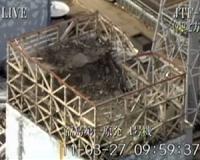| . |  |
. |
Sendai, Japan (AFP) March 29, 2011 Japan said Tuesday it was on "maximum alert" over a crippled nuclear plant where radioactive water has halted repair work and plutonium has been found in the soil. The earthquake and tsunami that ravaged Japan's northeast coast and left about 28,000 dead or missing also knocked out reactor cooling systems at the Fukushima plant, which has leaked radiation into the air and sea. Prime Minister Naoto Kan conceded the situation at the coastal atomic power station remained "unpredictable" and pledged his government would "tackle the problem while in a state of maximum alert". In a stop-gap measure to contain the crisis at the plant, crews have poured thousands of tons of water onto reactors where fuel rods are thought to have partially melted, and topped up pools for spent fuel rods. But the run-off of the operation has accumulated in the basements of turbine rooms connected to three reactors and filled up tunnels, making it too risky for workers to go near to repair cooling systems needed to stabilise the plant. One tunnel alone holds 6,000 cubic metres (212,000 cubic feet) of contaminated water, more than two Olympic swimming pools. Still, the only choice for now is to keep pumping water, said government spokesman Yukio Edano. "Continuing the cooling is unavoidable... We need to prioritise injecting water," Edano told reporters. If the rods are fully exposed to the air, they would rapidly heat up, melt down and spew out far greater plumes of radiation at the site, located about 250 kilometres (155 miles) northeast of Tokyo, nuclear experts fear. Workers have piled sandbags and concrete blocks around the tunnel shafts to contain the water, the nuclear regulatory body said. They have now also restored light in the control rooms of reactors one to four. The water out of reactor two has measured 1,000 millisieverts per hour -- four times the recently-hiked total exposure limit for emergency staff, and a level that can cause radiation sickness with nausea and vomiting in an hour. Adding to the nuclear fears, embattled operator Tokyo Electric Power Co. (TEPCO) said plutonium had been detected in soil samples that were taken a week ago at five spots in the plant. Nuclear safety agency spokesman Hidehiko Nishiyama said the plutonium data suggested "certain damage to fuel rods", Kyodo News reported. The US environmental protection agency says internal exposure to plutonium "is an extremely serious health hazard" as it stays in the body for decades, exposing organs and tissue to radiation and increasing the risk of cancer. TEPCO shares plunged 18.67 percent on Tuesday, and have now lost nearly three quarters of their pre-crisis value. News reports said the government is considering taking a majority stake in the power company. Fears have grown in Japan over food and water safety, and vegetable and dairy shipments from four prefectures have been halted. Seawater close to the plant earlier contained iodine-131 as high as 1,850 times the legal limit, but levels fell later and officials say tidal dispersal means there is no immediate health threat from seafood. Japan's government has evacuated hundreds of thousands of people from within 20 kilometres of the plant, and more recently encouraged those remaining within 30 kilometres to also leave. Environmental watchdog Greenpeace, which has taken its own measurements in the town of Iitate, 40 kilometres from the plant, urged the government to evacuate the town, especially children and pregnant women. "Remaining in Iitate for just a few days could mean receiving the maximum permissible annual dose of radiation," Greenpeace radiation expert Jan van der Putte said. Jitters continued throughout Asia, with China, South Korea, the Philippines and Vietnam reporting that radiation had drifted over their territories, even though they emphasised the levels were so small there was no health risk. Traces of radioactive iodine believed to be from Japan's damaged nuclear plant have even been detected as far afield as Britain, officials said Tuesday. "We would like to ask the public not to panic. These are very tiny amounts in the air," Philippine Nuclear Research Institute spokeswoman Tina Cerbolis said, echoing officials in the other countries to have detected the radiation. French President Nicolas Sarkozy, who currently heads the G8 and G20 blocs, will travel to Japan Thursday to meet Prime Minister Kan as a show of solidarity, according to his office. The United States said it would send Japan radiation-resistant robots and trained staff to operate them, aiming to collect information about the reactors from areas too unsafe for humans to enter.
Share This Article With Planet Earth
Related Links Bringing Order To A World Of Disasters A world of storm and tempest When the Earth Quakes
 Fukushima: still a crisis situation, say experts
Fukushima: still a crisis situation, say expertsParis (AFP) March 28, 2011 Critically damaged reactors at the Fukushima nuclear plant are still leaking radioactive pollution into the air, and probably into the soil and sea, say experts. Here's an update on the nature of the damage, and just how bad things could get: Q: How serious is contamination at the nuclear facility? A: Radioactivity levels at the Fukushima plant are very high due to gaseous discharges ... read more |
|
| The content herein, unless otherwise known to be public domain, are Copyright 1995-2010 - SpaceDaily. AFP and UPI Wire Stories are copyright Agence France-Presse and United Press International. ESA Portal Reports are copyright European Space Agency. All NASA sourced material is public domain. Additional copyrights may apply in whole or part to other bona fide parties. Advertising does not imply endorsement,agreement or approval of any opinions, statements or information provided by SpaceDaily on any Web page published or hosted by SpaceDaily. Privacy Statement |